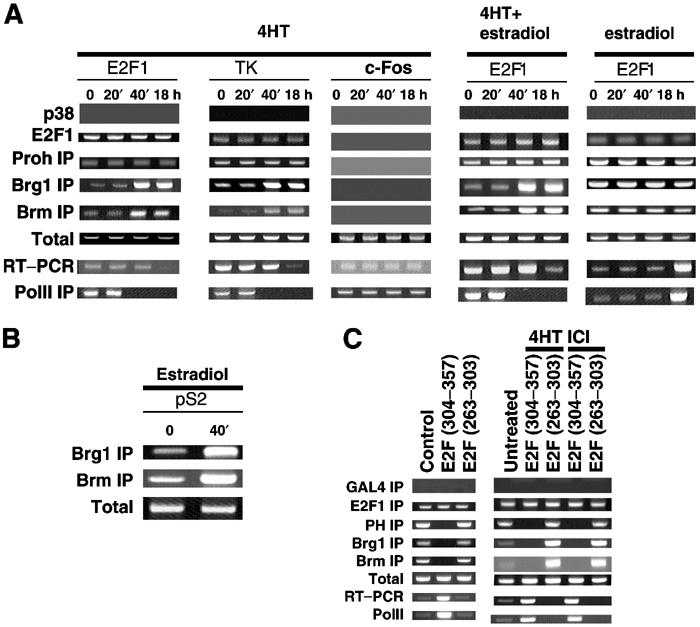Figure 6.

Estrogen antagonists induce the recruitment of Brg1 and Brm to native E2F-responsive promoters for transcriptional repression. (A) MCF7 cells were cultured in an estrogen-free medium for 3 days. The cells were then treated with tamoxifen alone, tamoxifen plus estradiol, or Estradiol alone, in separate experiments. Cell extracts were collected at the different time points as indicated and analyzed using an in vivo CHIP assay. The DNA recovered from the immunoprecipitates by the indicated antibodies was PCR-amplified, using primers against a region on each of the two E2F-responsive promoters (E2F1 and TK), and one non-E2F-responsive promoter (c-Fos), as a control. Higher levels of amplified products from the Brg1 or Brm antibodies were detected in the CHIP assays of the E2F-responsive promoters in the cells treated with 4HT for more than 40 min. This enhanced recruitment of Brm and Brg1 was not affected by co-treatment with estradiol. Amplified products from CHIP using E2F1 or prohibitin antibodies did not show variations in levels regardless of treatment. Control CHIP assay using p38 antibody, and CHIP assay on the c-Fos promoter using prohibitin, Brg1, Brm, and E2F1 antibodies, failed to generate any product, confirming the specificity of this assay. PCR using DNA directly isolated from the cell extracts produced products in all the lanes tested, serving as a positive control for the PCR reaction (Total). RT–PCR assays demonstrated a relative decrease in the levels of transcripts from the E2F-responsive genes in the tamoxifen-treated cells, but not the estradiol-treated cells, which instead produced increased levels of transcripts from E2F-responsive promoters. CHIP assay using PolII antibody demonstrated the transcriptional repression of E2F-responsive genes by tamoxifen and transcriptional induction by estradiol. (B) Positive control CHIP assay using anti-Brg1 and -Brm antibodies was performed on an estrogen-responsive promoter (pS2). Recruitment of Brm and Brg1 to the pS2 promoter was induced by estradiol. (C) MCF7 cells stably transfected with a vector encoding the prohibitin-binding domain of E2F (304–357) or control peptide (263–303). The expression of the transfected genes was confirmed by immunoblot shown in Figure 2C. A CHIP assay was performed on endogenous E2F1 promoter using Brg1, Brm, E2F1 prohibitin antibodies, and control antibody (Gal4). A significantly lower amount of PCR product associated with Brg1 or Brm was found when E2F (304–357) was present in the cells (left). The induction of Brg1 or Brm recruitment to the promoter by estrogen antagonists was blocked when E2F (304–357) was expressed.
